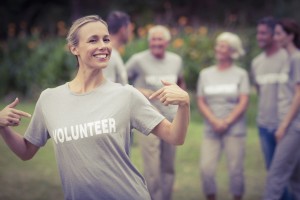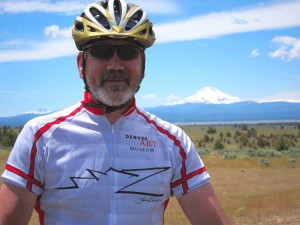Altruism and Sex

My genome is healthy.
Altruism is traditionally defined as: “behavior by an animal that is not beneficial to or may be harmful to itself but that benefits others of its species.” So here’s a simple question: why would anyone be altruistic?
One answer has to do with our relatives. Sociobiology suggests that all living creatures share one fundamental goal: to propagate our genes into future generations. Of course, the most direct way to propagate our genes is to reproduce.
But we can also propagate our genes by supporting our genetic relatives. So I might behave altruistically toward my sister because she shares much of my genome. If she reproduces successfully (and her children do as well), then some of my genetic heritage is passed on to future generations. So it pays to be nice to my sister. (It took me a long time to figure this out).
But why would anyone be altruistic toward someone who is not a genetic relative? According to Steven Arnocky’s recent paper in the British Journal of Psychology it has to do with another fundamental human drive: sex.
You may recall that competition for sex is a key element in maintaining the overall health of a species. When there is a fair amount of competition among males, females are remarkably good at picking out the best mates. What does “best” mean in this sense? The best men for producing healthy offspring who can in turn produce healthy offspring of their own.
So how do females know which males will produce the best offspring? Some of it is physical. For instance, females strongly prefer males who are symmetric rather than asymmetric. Being symmetric is, apparently, a good marker of genetic health.
Behavior also plays a role. We know, for instance, that creativity plays a strong role in mate selection – for both men and women. Ornamental creativity is especially attractive. Strictly speaking, ornamental creativity is not essential to survival. So those who display this trait are effectively advertising “I have more than enough to survive plus some left over for ornamentation. I have an abundance of what you want.”
According to Arnocky’s paper, non-kin altruism plays a similar role to creativity. It’s a behavior that is desirable to the opposite sex. The study used two different methods to measure altruism and then correlated the degree of altruism with sexual activity. Those who scored higher on altruism, “…reported having more sex partners, more casual sex partners, and having sex more often within relationships.” The correlation was stronger for men than women, suggesting that altruism is more important for women selecting men than for men selecting women.
In an interview, Arnocky summed up the results by noting that, “”It appears that altruism evolved in our species, in part, because it serves as a signal of other underlying desirable qualities, which helps individuals reproduce.”
Based on Arnocky’s findings, we may have been defining altruism improperly. The classic definition says that altruism doesn’t benefit the individual but does benefit the species. But Arnocky’s paper points out a very direct benefit to the individual – better mates and more of them. Given this, we need to re-phrase our initial question. It probably should be: why wouldn’t everyone be altruistic?
(Less technical summaries of Arnocky’s paper are here and here).
Are You The Boss Of You?

I am the master of my fate. Aren’t I?
Like so many teenagers, I once believed that “I am the master of my fate, I am the captain of my soul.” I could take control, think for myself, and guide my own destiny.
It’s a wonderful thought and I really want to believe it’s true. But I keep finding more and more hidden persuaders that manipulate our thinking in unseen ways. In some cases, we manipulate ourselves by mis-framing a situation. In other cases, other people do the work for us.
Consider these situations and ask yourself: Are you the boss of you?
- When you eat potato chips, are you thinking for yourself? Or is some canny food scientist manipulating you by steering you towards your bliss point?
- When you gamble in a casino, are you in control or is the environment influencing you to spend a little more and stay a little longer?
- When you eat chocolate, is it because you love the taste or because the microbes in your gut are controlling your behavior?
- When you play the slot machines, are you deciding how much to spend or is a sophisticated algorithm dispensing just enough winnings to keep you hooked? Are you being addicted in the machine zone?
- When you read social media, do you decide how long to stay on or does a slow, steady drip of dopamine keep you engaged?
- When you don’t eat fish for 20 years, is it because you’re allergic or did you just never think to test your own assumptions? Did you frame yourself?
- When you go rock climbing, is it because you’re an adventurous spirit or because your slow heart beat tilts your life towards cheap thrills (and perhaps a life of crime)?
- When you chat with people in your neighborhood, do they express a wide range of opinions or do they all think more or less like you? When you surf the Internet, do you read only items that you agree with? Will that make you crazy?
- When you vote for a political candidate, is it because you have carefully considered all the issues and chosen the best candidate or because a cynical communications expert has got your goat with attributed belittlement?
- When you vote for stronger anti-crime laws, is it because you think they’ll actually work or are you succumbing to the vividness availability bias? (Vivid images of spectacular crimes are readily available to your memory so you vastly over-estimate their frequency).
- Why are so many restaurants painted red? Why is the woman in the picture (above) wearing a red outfit?
- Is the future ahead of you or behind you? Why did you make that choice?
- When you make a big decision for your company, you never let your biases get in the way, do you? Yet when other people make big decisions, they’re biased most of the time, aren’t they?
- When you choose a mate, are you thinking clearly or is sociobiology influencing your behavior?
- Did you carefully consider and consciously choose those activities that arouse you sexually or was the decision made for you by some combination of hormones, psychology, and genetics?
- Is your primary responsibility as an inhabitant of a given country to be a good citizen or a good consumer?
- When you buy something is it because you need it or because you want it? Perhaps you’re being manipulated by Sigmund Freud’s nephew, Edward Bernays, the founder of public relations. Or perhaps you’ve been brandwashed.
In The Century of the Self, a British video documentary, Adam Curtis argues that we were hopelessly manipulated in the 20th century by slick followers of Freud who invented public relations. Of course, video is our most emotional and least logical medium. So perhaps Curtis is manipulating us to believe that we’ve been manipulated. It’s food for thought.
(The Century of the Self consists of four one-hour documentaries produced for the BBC. You can watch the first one, Happiness Machines, by clicking here).
The Biology of Bad Behavior

Rock climbing, biking, or violent crime?
My resting heart rate is 56 beats per minute. I’ve always interpreted that as a sign of good health. It may also mean that I’m a natural born killer.
That’s one of the conclusions that Adrian Raine might like you to draw from his new book, The Anatomy of Violence: The Biological Roots of Crime. Raine’s work is essentially a continuation of E.O. Wilson’s research on sociobiology. Wilson linked evolutionary and genetic influences to human behavior and, especially, to our reproductive habits, urges, and processes.
Raine takes sociobiology a step farther. If our genes can influence our reproductive behaviors, could they not also influence violent and criminal behavior? Are criminals different than non-criminals in some biological way? If so, can we use biology to predict who will commit crimes? Then what?
Let’s take low heart rate, for example. Raine reports evidence that a significant number (much higher than chance) of antisocial criminals have lower than average resting heart rates. Further, the condition points toward violent crime and not to other forms of behavior. It’s not only a predictor; it’s also a specific predictor.
Why would low heart rate point to violent crime? Raine offers three theories. First, there’s the fearlessness theory — “A low heart rate is thought to reflect a lack of fear.” Second is the low empathy theory – “Children with low heart rates are less empathic than children with high heart rates.” Third is the stimulation-seeking theory – low heart rate is associated with low arousal and “…those who display antisocial behavior seek stimulation to increase their arousal levels…”
I’m going with stimulation-seeking theory. Perhaps that’s why I took up rock climbing at the tender age of 18. I just needed some stimulation.
So, what might we have predicted about my behavior when I was, say, 15? It might have been this: “Travis has a low heart rate. Therefore, we can safely predict that he will either become a rock climber or a psychopathic serial killer.” Hmm… now what?
Let’s say I do commit a crime. Does my low heart rate absolve me of responsibility? Should a jury put me in jail or simply require that I take stimulants to boost my heart rate? Or should the government require me to take such stimulants before I commit a crime, just to be on the safe side?
It’s a debate we need to have and Raine begins to frame it up. Unfortunately, he’s rather sloppy. For instance, he seems to make a fundamental error in explaining correlation and variability.
Raine, with fellow researcher Laura Baker, studied whether violent behavior can be inherited. They used “sophisticated statistical techniques” (multivariate analysis) to estimate the heritability of such behavior. Raine writes that he and Baker found, “Heritabilities that ranged from .40 to .50. That means that 40 to 50 percent of the variability among us in antisocial behavior is explained by genetics.”
Multivariate analysis, however, sorts out correlations, not variability. The degree of variability is not the correlation itself but rather the square of the correlation. With a correlation of .40, for instance, the square is .16. If X and Y have a correlation of .40, then 16% of the variability in Y is explained by X. Thus, Raine and Baker can explain between 16% and 25% of the variability in antisocial behavior through inheritance. That’s an important finding but not nearly as strong as Raine claims. It’s a fundamental mistake and weakens the argument considerably.
Elsewhere, Raine writes that Ted Bundy killed approximately 35 women. A few pages later, Bundy’s victims total more than 100. Raine informs us that his wife, sister, and cousin are all nurses. Therefore, he picks a nurse, “Jolly” Jane Topppan, to illustrate the “breakdown in the moral brain”. I don’t understand why Jolly Jane illustrates such a breakdown better than, say, Ted Kaczynski, the Unabomber (who, by the way, has a resting heart beat of 54).
I find this irksome because I generally agree with Raine’s claims. Biology does influence our behavior. Through poor editing and sloppy statistics, however, he undermines his own argument. Raine’s book is a good start but I hope a stronger, more tightly reasoned book comes along soon. In the meantime, I need some stimulation. I think I’ll take up nude skydiving.